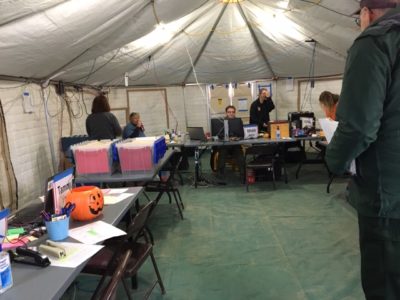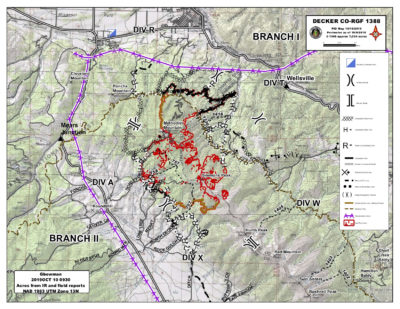Conditions for firefighters working the Decker Fire got even more dramatic Thursday. Overnight wind chill may drop to below zero on the mountain and in the crew camp at the Chaffee County Fairgrounds, from a cold front sweeping down from the north into Colorado.

The Decker Fire camp gained more yurts on Thursday, as the crews were given better shelter, firefighter sleeping areas were strengthened, and generators and heaters were brought in. (Photo by Jan Wondra)
While the area did not receive much of the hoped-for precipitation along with the colder temperatures, humidity rose today to 60-65 percent.
The dramatic shift from record warm, dry weather had the Decker Fire logistics teams setting up 26 extra yurts and organizing generators, heaters, lights, and providing antifreeze for equipment.
Operations for the firefighters, thanks the public for their concern, and assures the community that the 904 firefighters and crew members have warm, dry places to sleep.
On the mountain, the fire has grown to 7,034 acres and remains 14 percent contained. At this point, although the actual cost isn’t yet known, incident command estimates this federal response is already close to $17 million.
Heavy fuels are feeding the fire, but with higher humidity, it hasn’t advanced much today. Yesterday, residents in Howard experienced smoky conditions and moderate fire behavior from two “fingers” of the fire, driven east by strong winds.
The Decker Fire is divided into two Branches:
Branch I (on the northeast side by Salida) and Branch II (on the southwest side the San Luis Valley). Then subdivided into five divisions.
Branch I - Salida
• Division T (northeast side by Wellsville)
• Division R (north side by Salida)
• Division W (southeast side by Howard)
• Division A (west side by Poncha Pass)
• Division X (south side by Alder)
On the north side of the fire, Division R completed their bulldozer fire line work along CR 124 and Rainbow Trail. On the northeast side of the fire, Division T completed their hand line running from Columbine Trail south along Rainbow Trail.

Gayle Laurant, from the Big Horn National Forest in Wyoming, was one of the Decker Fire check-in crew members. Every person here for a Decker Fire role checks in at this yurt. (Photo by Jan Wondra)
Division W, on the southeast side of the fire, completed contingency lines west of Howard. Structural protection crews are continuing to work in and around Howard and with the cold weather, working to protect pumps and hoses from freezing.
There is an approved burn plan for firing operations, designed to clear fuels and stop the advance of the fire in selected areas. That firing operation requires the coordination of helicopter crews and ground crews. But execution will wait for the right weather conditions.
Terrain maps of the fire on Thursday include a new (brown) line, indicating a section of the fire edge that presents ‘minimal threat’ from fire action, requiring limited action. These areas are in extreme terrain where they don’t expect the fire to spread so that they won’t be risking firefighter safety in those areas.
Some evacuations in the Bear Creek area of Fremont County remain in effect. Those areas formerly evacuated, to which residents have been allowed to return, remain closed to all but residents.
The terrain in those areas is still considered dangerous, with structural protection equipment still on the ground, as well as fallen trees, ash pits, and engines on access roads.
Only two structures have been lost so far: one in Fremont County at the bottom of Bear Creek, and another structure in Chaffee County.
“My family would like the focus to be on the firefighters,” said Jessica Wilda of Howard, whose parent’s home lost a garden shed. “The fire came close, but the firefighters saved their home.”

The Decker Fire Camp Finance Division at work in a yurt with extra insulation. (Photo by Jan Wondra)
With record low temperatures expected overnight, incident command says fire managers will scout the fire access roads again, to determine driving conditions on the mountain access roads.
Decker Fire Information Office
Fire Info Line: (719) 626-1095
InciWeb: www.inciweb.nwcg.gov/incident/6592
Facebook: facebook.com/DeckerFire2019
Editor’s Note: Firefighter crews from all across the country are involved in the Decker Fire, working in conditions including deep ash, and fires burning underground along tree roots. The cover photo, courtesy http://www.pri.orgwww.pri.org, is of a fire crew from American Samoa, at work on a fire in California last year. They sing to stay motivated on the job.
The Decker Fire is divided into two Branches:
Branch I (on the northeast side by Salida) and Branch II (on the southwest side the San Luis Valley). Then subdivided into five divisions.
Branch I - Salida
• Division T (northeast side by Wellsville)
• Division R (north side by Salida)
• Division W (southeast side by Howard)
• Division A (west side by Poncha Pass)
• Division X (south side by Alder)








Recent Comments